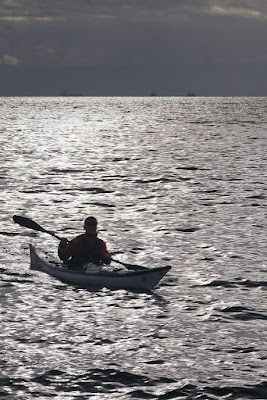..the old pier at Arrochar and so did not have nearly half a kilometer of sticky black mud to negotiate at the head of Loch Long.
Once on the water, the Phil was dwarfed by the jagged ramparts of the Cobbler. The first of the winter snows clung to the dark rocks of the high corries.
We set off SW down Loch Long towards the distant open sea. We were hemmed in on both sides by the mountain slopes...
...that now plunged into the sea but which had once confined the glacier that had gouged out Loch Long during the Ice Ages. The SE side of the valley that contains the loch was in deep shade and our breath froze into icy crystals in the cold morning air.
We moved over to the sunny side of the loch where we passed the remains of the abandoned Admiralty buildings which were the headquarters of the Loch Long Torpedo Range. The range opened in 1912 and remained open until 1986. During WW1 in 1915, a Uruguayan national, Augusto Alfredo Roggen, was arrested at the the nearby Tarbet Hotel. He said he was on a fishing holiday and had a map of the area (including the restricted area at the head of Loch Long) in his possession. He raised suspicion as he had arrived without rods and a when he was arrested, a revolver, ammunition and invisible ink were found in his room. Although the police were very smart to find the invisible ink, what really damned him was, that in Britain, the revolver was considered a very unsporting way to catch fish. He was transported to the Tower of London and although the Loch Long fish were spared the bullet, he was not. In 1915 Britain, fish enjoyed a longer life than spies.
We would need to be careful...

















































